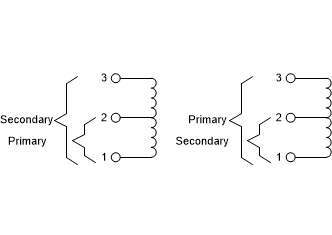SLAA898 September 2022 TAS3251 , TPA3255
2.4 Auto-Transformer
Figure 2-2 shows a conventional double-wound transformer. An auto transformer has a similar magnetic core, but only one winding. This winding is shared between the primary and secondary side. Auto transformers can be designed as step-up or step-down transformers. To implement a step-up transformer, a small AC voltage is applied to a portion of the winding, representing the primary side. The output voltage is then taken across the entire winding, representing the secondary side. See Figure 2-3 for the step-up auto-transformer. The opposite is true for a step-down transformer. By applying a voltage across the entire winding and taking the output across a smaller portion, the auto-transformer converts into a step-down transformer.
The basic working principle between a conventional double-wound transformer and an auto transformer is similar. The main advantages of an auto-transformer are smaller size, and reduced copper winding and core material for the same VA rating. Since there is less material, both copper loss and iron loss can be less than a double-wound transformer. Auto-transformers can also be used in constant voltage systems to reduce the cost and power loss, as well as make it easier to install and transport.
The main disadvantage of an auto-transformer is the lack of electrical isolation, which might be a safety concern. For example, when using a step-down auto-transformer, if the secondary side is an open circuit, the primary voltage is all on the load, and causes much more power than intended. Or, if there is short-circuit on the secondary side, the resulting primary current is much higher than a conventional double-wound transformer.
 Figure 2-2 Conventional Double-Wound
Transformer
Figure 2-2 Conventional Double-Wound
Transformer Figure 2-3 Step-Up and Step-Down
Auto-Transformers
Figure 2-3 Step-Up and Step-Down
Auto-Transformers